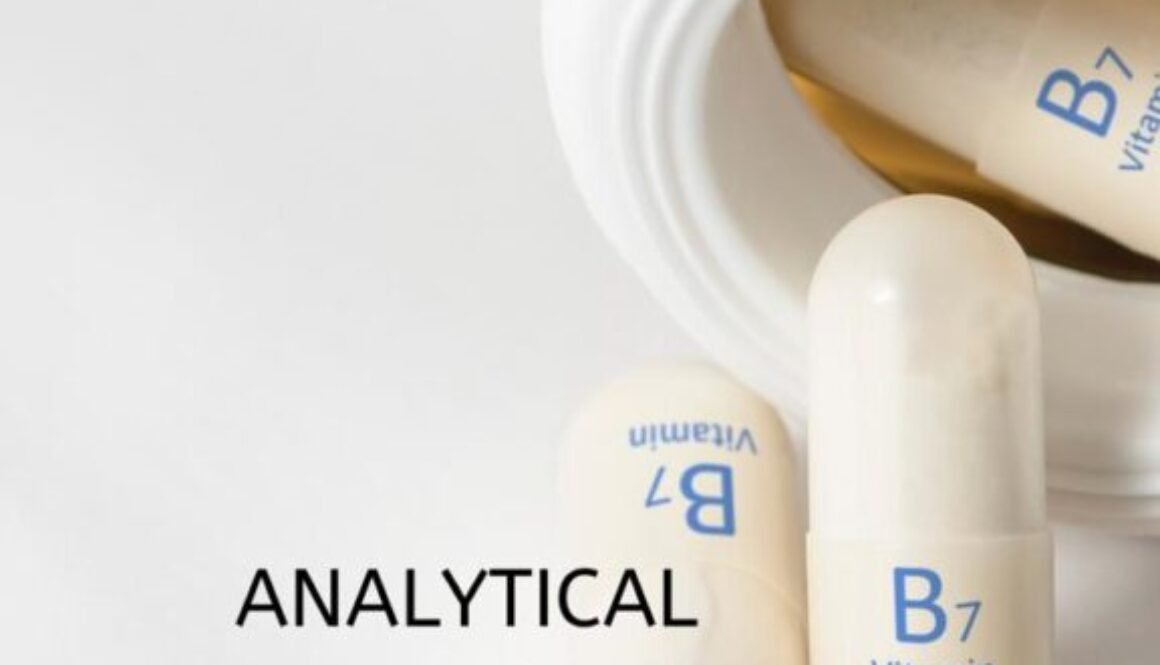ANALYTICAL METHOD FOR THE DETECTION OF BIOTIN
Here are the two main analytical methods for the detection of Biotin (Vitamin B7):

MICROBIOLOGICAL ASSAY
- This is a traditional method based on the growth response of a biotin-auxotrophic microorganism (a microbe requiring biotin for growth).
- Process:
- A standard biotin solution is serially diluted to create a concentration range.
- The test sample is also diluted appropriately.
- Both the diluted standards and test samples are added to cultures of the biotin-auxotrophic microorganism.
- The cultures are incubated, and the growth of the microorganism is measured.
- Increased growth is observed with increasing biotin concentration.
- Advantages:
- Relatively simple and inexpensive method.
- Highly specific for biotin.
- Limitations:
- Time-consuming, requiring incubation and growth measurement.
- Requires expertise in microbiology and maintaining the microorganism culture.
HIGH-PERFORMANCE LIQUID CHROMATOGRAPHY (HPLC)
- This is the preferred modern method for biotin detection due to its versatility and higher sensitivity.
- There are two main approaches for using HPLC: a) Reverse-Phase HPLC (RP-HPLC):
- Most common approach.
- Separates compounds based on their hydrophobicity (water vs. fat solubility).
- Requires a specific mobile phase (solvent mixture) and detection at the appropriate wavelength (usually UV). b) HPLC with Avidin-Based Affinity Chromatography:
- Highly specific method.
- Utilizes a column containing immobilized avidin (a protein with high affinity for biotin).
- Biotin in the sample binds to the avidin column, while other components flow through.
- Bound biotin is then eluted with a specific solution and detected.
- Advantages:
- Faster analysis time compared to microbiological assay.
- Higher sensitivity, allowing detection of lower biotin concentrations.
- Can be combined with various detectors (UV, fluorescence) for improved analysis.
- RP-HPLC can be used for quantitative analysis of biotin.
- Limitations:
- Requires more sophisticated instrumentation and expertise compared to the microbiological assay.
- Affinity chromatography with avidin is highly specific but can be more complex to set up.
CHOOSING THE RIGHT METHOD
- Routine analysis or for initial screening: Microbiological assay might be suitable if resources are limited.
- For accurate quantification, higher sensitivity, or faster analysis: HPLC (particularly RP-HPLC) is the preferred method.
- If high specificity for biotin is crucial: HPLC with avidin-based affinity chromatography can be considered.
ADDITIONAL CONSIDERATIONS
- Sample preparation is crucial for accurate analysis with either method, especially for complex samples like food or supplements, to remove interferences.
- The choice of method depends on the specific needs of the analysis (e.g., qualitative screening vs. quantitative determination).
- Due to the lack of chromophores in the molecular structure of biotin, it gives very weak absorbance in the UV region mainly 200-210 nm, with an absorbance maximum at 204 nm. Therefore, direct HPLC-based methods using UV detectors were only recommended for biotin assay for highly concentrated sample concentration.
CONCLUSION
While both microbiological assay and HPLC offer options for biotin detection, HPLC is the preferred method for its speed, sensitivity, and versatility. The specific type of HPLC technique (RP-HPLC or avidin-based affinity chromatography) can be chosen based on the desired level of specificity and complexity of the analysis.
